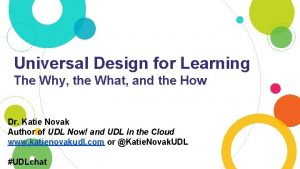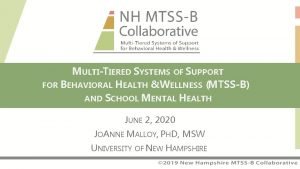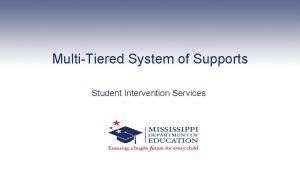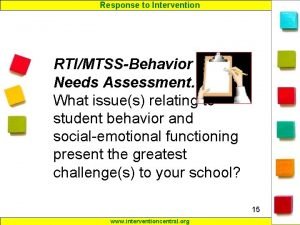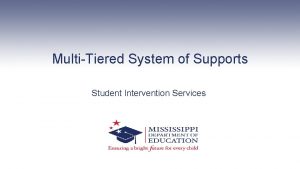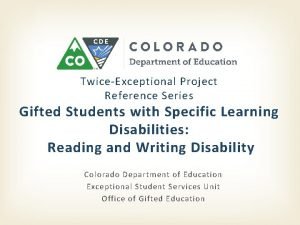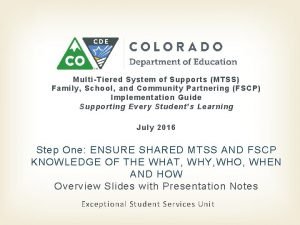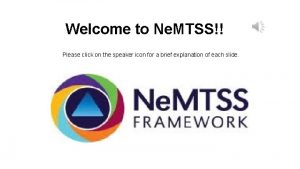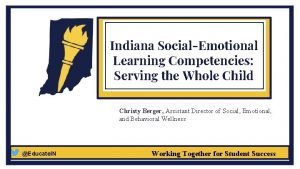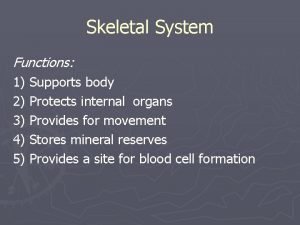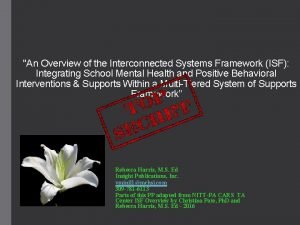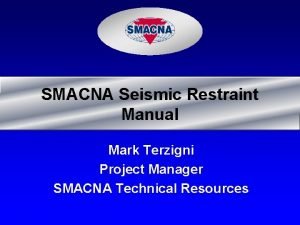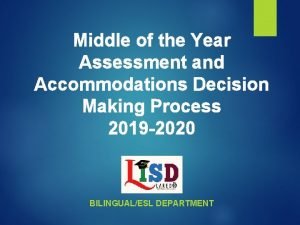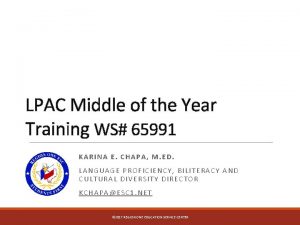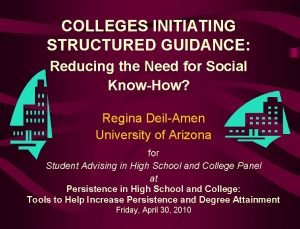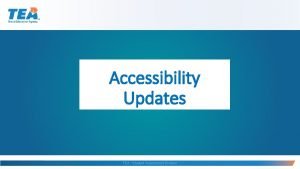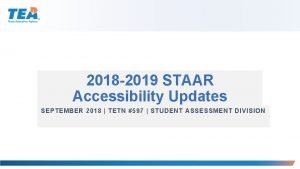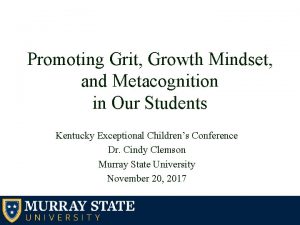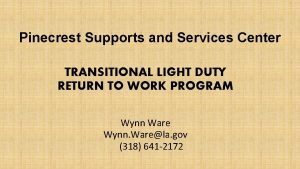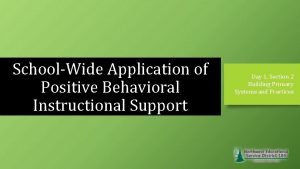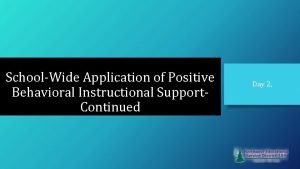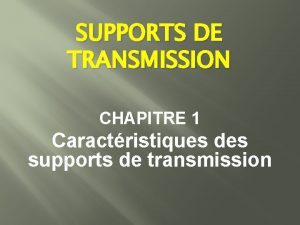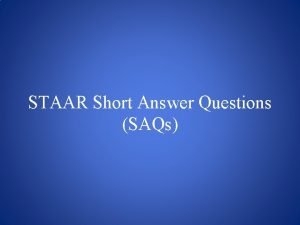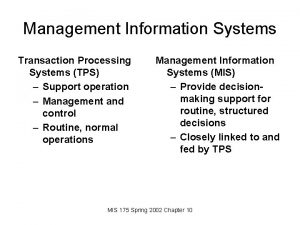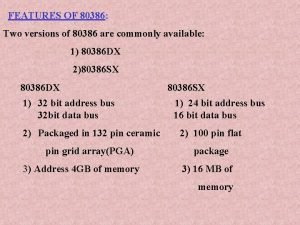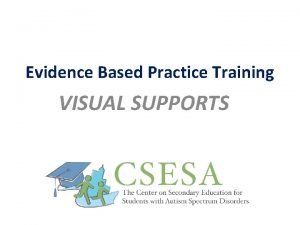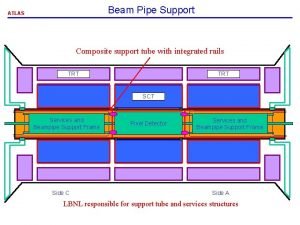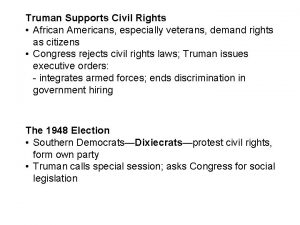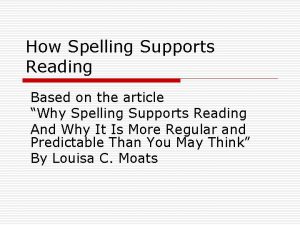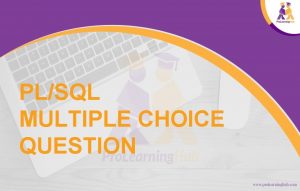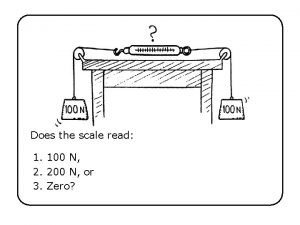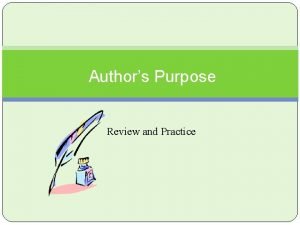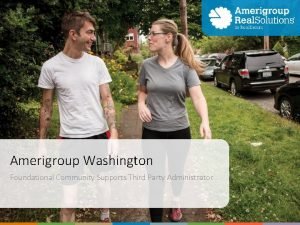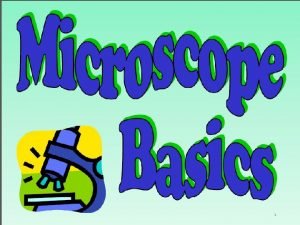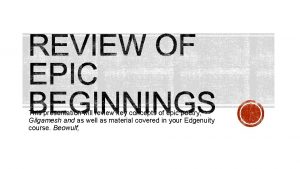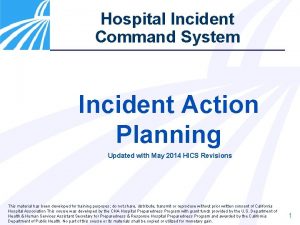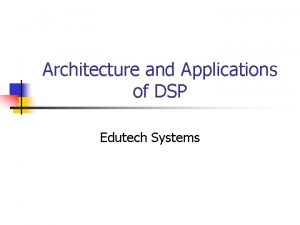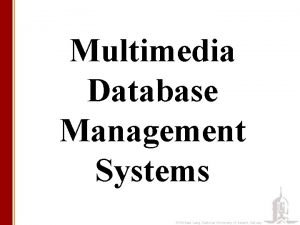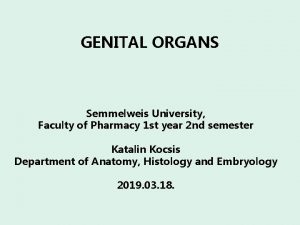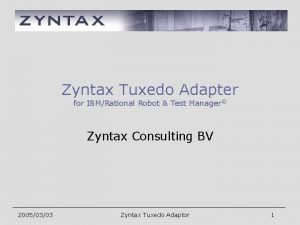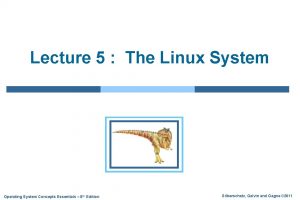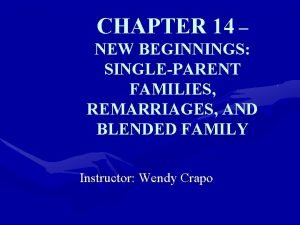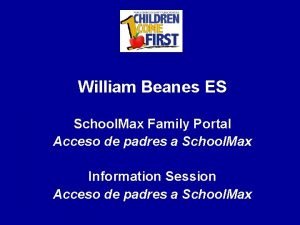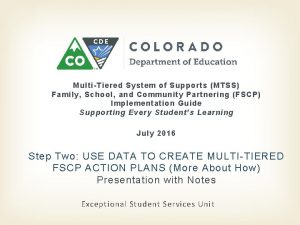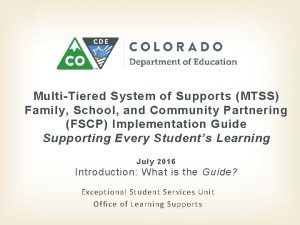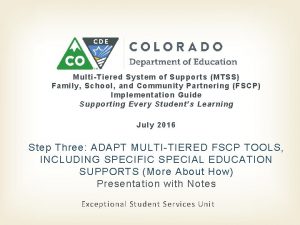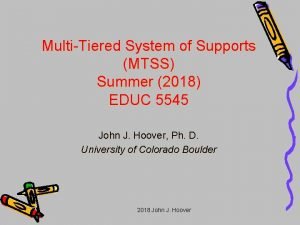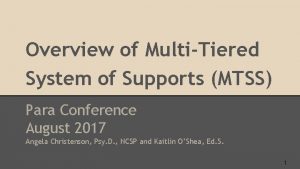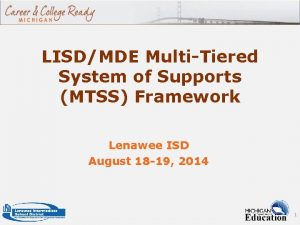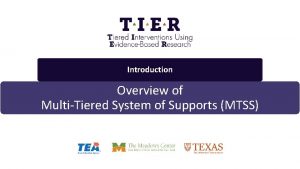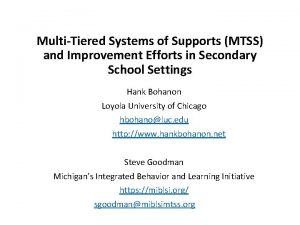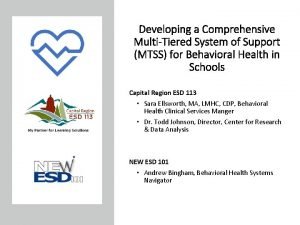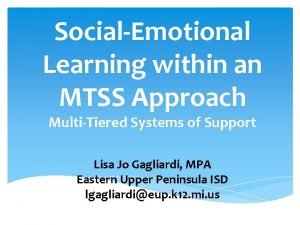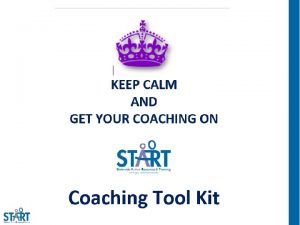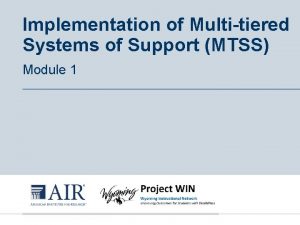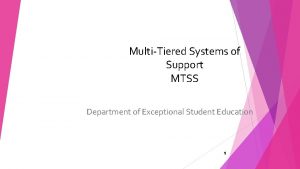MultiTiered System of Supports MTSS Family School and



































































- Slides: 67

Multi-Tiered System of Supports (MTSS) Family, School, and Community Partnering (FSCP) Implementation Guide Supporting Every Student’s Learning July 2016 Step One: ENSURE SHARED MTSS AND FSCP KNOWLEDGE OF THE WHAT, WHY, WHO, WHEN AND HOW Overview Slides with Presentation Notes Exceptional Student Services Unit

Apply to Site or Situation § Share the What, Why, Who, and When of Family, School, and Community Partnering § Use a Multi-Tiered, Layered Continuum of Supports for Students and Families § Implement the National Standards for Family-School Partnerships for EVERY Family and Educator § Create a Dual Capacity-Building Framework

CDE Strategic Goals: …and… Every Student Every Step of the Way Family Graduate ready Start strong Read by third grade Meet or exceed standards

MTSS FSCP Implementation Guide: Outcomes Each adult learner will: 1. Access the research & legal base describing how partnering positively supports academic and behavioral learning 2. Implement partnering within a Multi-Tiered System of Supports (MTSS) framework, applying the National Standards for Family-School Partnerships ; actively team throughout the special education process. 1. Apply each of these three steps to one’s site or situation, using adult learning principles: § ENSURE SHARED MTSS AND FSCP KNOWLEDGE OF THE WHAT, WHY, WHO, WHEN, AND HOW § USE DATA TO CREATE MULTI-TIERED FSCP ACTION PLANS (MORE ABOUT HOW) § ADAPT MULTI-TIERED FSCP TOOLS, INCLUDING SPECIFIC SPECIAL EDUCATION SUPPORTS (MORE ABOUT HOW) 2. Practice ongoing, strategic, effective partnering every day.

Family, School, and Community Partnering Adult Learning All adult stakeholders are adult learners: family members, educators, community collaborators. Adult learning refers to a collection of theories and methods for describing the conditions under which the processes of learning are optimized. Specific, effective factors incorporated into this Guide include: § Introductory Information § Self-instruction § Demonstration § Application § Reflection and Evaluation § Multiple Hours Over Time (Trivette, Dunst, Hamby, & O’ Herin, 2009)

Closing the FSCP Implementation Gaps Research Practice Belief Practice Law Practice Resources Practice

MTSS FSCP Implementation Guide Three Steps § Step One: ENSURE SHARED MTSS AND FSCP KNOWLEDGE OF THE WHAT, WHY, WHO, WHEN, AND HOW Partners benefit from sharing the same evidence and understanding of effective collaboration to support student learning. § Step Two: USE DATA TO CREATE MULTI-TIERED FSCP ACTION PLANS Partners continuously improve their collaborative efforts when they use data to strategically plan, evaluate, and revise goals. § Step Three: ADAPT MULTI-TIERED FSCP TOOLS, INCLUDING SPECIFIC SPECIAL EDUCATION SUPPORTS Partners can be efficient, timely, and strategic when they access specific resources and apply those supports to their sites or situations.

MTSS FSCP Implementation Guide Four Areas of Study For each step, the Implementation Guide includes: A. Information § Articles, Research Briefs § Tools, Data Sources B. Demonstration § Videos § Stories From the Field C. Application § Activities Applied to Site, Situation D. Resources § Documents, Websites, Organizations, and Books

Step One: ENSURE SHARED MTSS AND FSCP KNOWLEDGE of THE WHAT, WHY, WHO, WHEN, AND HOW Partners benefit from sharing the same evidence and understanding of effective collaboration to support student learning. § This Step includes information on the following: § Multi-Tiered System of Supports (MTSS) § Family, School, and Community Partnering (FSCP) § WHAT § WHY § WHO § WHEN § HOW § This overview presentation includes slides and presentation notes which can be used by school communities.

Step One: ENSURE SHARED KNOWLEDGE Multi-Tiered System of Supports (MTSS)

Response to Intervention (Rt. I) Colorado Legislation Response to Intervention (Rt. I) is incorporated within a Multi. Tiered System of Supports (MTSS) 1. One of the criteria for a specific learning disability (SLD)… The child does not make sufficient progress to meet age or state-approved grade-level standards in the area(s) identified when using a PROCESS BASED ON THE CHILD’S RESPONSE TO SCIENTIFIC, RESEARCH-BASED INTERVENTION. (ECEA, CDE, 2007) 1. SACPIE shall inform … concerning best practices and strategies… for increasing parent involvement in public education and promoting family and school partnerships, in… (c) Involving parents in RESPONSE TO INTERVENTION PROGRAMS in public schools and districts. (SB 09 -90) 2. If a student’s reading levels are below grade level … or if the student has a significant reading deficiency, the local education provider shall ensure that the student receives appropriate interventions through the RESPONSE TO INTERVENTION FRAMEWORK. (READ Act, HB 12 -1238)

Multi-Tiered System of Supports (MTSS) Academic Supports Rt. I Family and MTSS Community Supports PBIS Behavior Supports

8 Guiding Principles of SW PBIS 1. Administrative Leadership 2. Team Implementation 3. Define Concrete Expectations 4. Teach Behavior Expectations 5. Acknowledge and Reward Positive Behavior 6. Monitor and Correct Behavior 7. Use Data for Decision Making 8. Family and Community Partnerships 6 Components of Rt. I 1. Leadership 2. Problem Solving 3. Curriculum and Instruction 4. Assessment/Progress Monitoring 5. Positive School Climate and Culture 6. Family, School, and Community Partnering MTSS Components • Team-Driven Shared Leadership • Data-Based Problem Solving & Decision. Making • Layered Continuum of Supports • Evidence-Based Practices • Family, School, and Community Partnering

Definition: Multi-Tiered System of Supports (MTSS) in Colorado CO-MTSS is a prevention-based framework of team-driven data-based problem solving for improving the outcomes of every student through family, school, and community partnering and a layered continuum of evidence-based practices applied at the classroom, school, district, region, and state level.


MTSS Definition “chunked out” § § § § Prevention-based Framework Team-driven Data-based Problem solving Improved outcomes Every student § Family, school, and community partnering § Layered continuum § Evidenced-based practices § Classroom, school, district, regional, and state level


MTSS is Data-Driven (CO MTSS Problem Solving Process) • Problem-solving teams represent the educational setting. • Family members are partners at all levels in the problem-solving process. • There is efficient collection and use of data. • The process is informed by data and the team is informed by data. • Problem-solving teams use data to make decisions.

MTSS is Prevention-Based Preventative Approach Applied Across All Tiers § Identify who needs support as early as possible; Implement supports when needed; and Determine if those supports are effective § Prevent development of new problems § Reduce the number of existing challenges § Reduce the intensity and complexity of needed supports

Learning Outcomes in MTSS “Academic Achievement + Social Competence” (Academic Learning) (Behavioral Learning) • Joint planning • A responsive of educators environment is and families created. results in • A culture of shared learning exists. accountability and improved MTSS Academic student Integrated Behavior Continuum achievement. Continuum (Note: Visual graphic Representation Adapted from OSEP PBIS TA Center)

Support Matched to Stakeholders’ Needs in MTSS e iv s n e Int g r Ta ive rsa Un (Note: Visual graphic Representation Adapted from Practitioners) l d e et “The Layered Continuum of Supports”

Step One: ENSURE SHARED KNOWLEDGE What, Why, Who, When, Why and How of Family, School, and Community Partnering Exceptional Student Services Unit Office of Learning Supports

Family, School, and Community Partnering (FSCP) WHAT? • Definitions • Multi-Tiered, Layered FSCP • National Standards for Family-School Partnerships • Dual Capacity Framework Active partnering is a relationship demanding close collaboration, communication, and coordination between parties having shared responsibilities. (adapted from Christenson & Sheridan, 2001)

Partnering Principles § The focus is always on student success § It is about ongoing, sustainable, intentional relationships § Differences are directly addressed, so that: §students see their worlds working together. §a forum is created for understanding the culture of the family and the culture of the school (cultural sharing). (Garcia Coll & Chatman, 2005)

Research-Based Partnering Definitions § Family and Community Partnering is the collaboration of schools, families, and communities as equal partners in improving learner, classroom, school, and district outcomes. (CDE, 2013) § In effective Family and Community Partnering, each stakeholder shares responsibility for learners’ success by: • • • establishing and sustaining trusting relationships; understanding and integrating family and school culture; maintaining two-way communication; engaging in collaborative problem-solving: coordinating learning at home, school, and in the community, using data; • acknowledging and celebrating progress. (CDE, 2010)

More Partnering Definitions § Family-school partnering can be defined as the collaboration that drives student achievement. (Flamboyan Foundation, 2013) § Partnering is being on the same team and sharing goals and knowledge. (Family Member, 2014) § Family-school partnering is sharing responsibility for a student’s school success. (Lines, Miller, & Arthur-Stanley, 2011) § Partnering is coordinating learning between home and school by communicating and collaborating. (School Intervention Team, 2012)

Partnering Vocabulary § Words: “WE”, “OUR”, “US” § Goals: What do we want to ACHIEVE TOGETHER? § Roles: How can WE PARTNER around that? § Data: How will WE KNOW it is working? § Input: What does the family or school or community resource THINK, FEEL, KNOW? § Decisions: WE ALL are “at the table” and “on the team”. § Responsibilities: What are WE EACH doing? § Students: What is BEST for OUR student?

Multi-Tiered Family, School, and Community Partnering: Supporting EVERY Student’s Learning w Fe – is ve ilies en m Int Fa s e d te e g ar T r a F y ive rsa Un (Note: Visual graphic Representation Adapted from Practitioners) l ve E - – m So lie i m Fa ly i m “The Layered Continuum of Supports”

National Standards for Family-School Partnerships (National PTA, 2008) • • • Welcoming All Families Communicating Effectively Supporting Student Success Speaking Up for Every Child Sharing Power Collaborating with Community

Welcoming All Families into the School Community Families are active participants in the life of the school, and feel welcomed, valued, and connected to each other, to school staff, and to what students are learning and doing in class. § Create a welcome climate. § Build a respectful, inclusive school community. PTA (2009). PTA National Standards for Family-School Partnerships: An Implementation Guide.

Communicating Effectively Families and school staff engage in regular, two-way, meaningful communication about student learning. § Share information between school and families. § Communication should be two-way and on-going. PTA (2009). PTA National Standards for Family-School Partnerships: An Implementation Guide.

Supporting Student Success Families and school staff continuously collaborate to support students’ learning and healthy development both at home and at school, and have regular opportunities to strengthen their knowledge and skills to do so effectively. § Share information about student progress. § Support learning by engaging families. PTA (2009). PTA National Standards for Family-School Partnerships: An Implementation Guide.

Speaking up for Every Child Families are empowered to be advocates for their own and other children, to ensure that students are treated fairly and have access to learning opportunities that will support their success. § Understand how the school system works. § Empower families to support their own and other children’s success in school. PTA (2009). PTA National Standards for Family-School Partnerships: An Implementation Guide.

Sharing Power Families and school staff are equal partners in decisions that affect children and families and together inform, influence, and create policies, practices, and programs. § Strengthen the families’ voice in shared decision-making. § Build families social and political connections. PTA (2009). PTA National Standards for Family-School Partnerships: An Implementation Guide.

Collaborating with the Community Families and school staff collaborate with community members to connect students, families, and staff to expanded learning opportunities, community services, and civic participation. § Connect the school with community resources. § Have the school give back to the community. PTA (2009). PTA National Standards for Family-School Partnerships: An Implementation Guide.

THE DUAL CAPACITY – BUILDING FRAMEWORK (U. S. Department of Education, 2013)

Dual-Capacity Building Framework: Families & Educators Both Need… Capabilities (skills & knowledge) Connections (networks) Cognition (beliefs, values) Confidence (self -efficacy) U. S. Dept. of Ed. Dual Capacity-Building Framework (2013) http: //www. ed. gov/family-and-community-engagement

Family, School, and Community Partnering (FSCP) WHY? • • • Research Laws The Shift …parents are a child’s first teachers… (Adams, Boyd, Cunningham & Gailunas-Johnson, 2003)

Research: Time In and Out of School Students Spend More Than 70% Of Their Waking Hours Outside of School. During School Years (Waking Hours) 30% In School Out of School (Clark, 1990; Callender & Hansen, 2004) 70%

Research: Summary of 50 Years § For Students: § Higher achievement, more homework completion, come to school more and stay in school longer, observing more similarities between home and school. § For Families: § Becoming more supportive of child and teachers, becoming more confident in how to help child learn, learning more about education programs. § For Teachers and Schools: § Improved teacher morale, higher ratings of teachers by parents, parents support schools and bond issues. (Esler, Godber, & Christenson, 2008)

Research: Student Achievement On the Colorado TELL Survey, the teaching condition with the strongest connection to high student achievement and growth is: Community Support and Involvement …whether parents/guardians in the community are engaged, influential, and supportive of teachers and schools – across all school levels. This finding has been found in 2009, 2011, 2013! (New Teacher Center, 2014)

Research: Student Achievement The C’s: Coordinated or Connected or Continuous or Complementary Learning • Practice increases memory traces and fluency. • Spaced practice (school, then out of school) increases retention. • Applying learned knowledge in the real world reinforces concepts and increases generalization. • Summarizing learned information to others forces more in-depth processing and personal application. (Gage &Berliner, 1998)

Research: Student Achievement Home Environment Components That WORK AT ALL LEVELS - Supporting School at Home 1. Communication About School: Frequent and systematic discussions with child about school. Parents encouraging their children regarding schoolwork. Parents providing resources to help child do schoolwork (including community partnering). 2. Supervision of homework, TV viewing, after-school activities (including community partnering). (Marzano, 2003)

Research: Student Achievement § All students benefit from family-school partnering, including those who are at the secondary level and those who experience differences in culture, learning, and economic status. (Jeynes, 2005, 2007) § School-initiated, specific family participation programs – such as shared reading, homework checking, and teamed two-way communication – are significantly and positively related to academic achievement for students at all levels. (Jeynes, 2012)

Research: Student Achievement Homework has a positive effect on achievement. The key is in the design. § Communicate regularly about homework expectations – two-way! § Ensure every child is successful. § Guide families in supporting learning at home. § Jointly problem-solve concerns early. § Try Interactive Homework (TIPS – Teachers Involving Parents in Schoolwork). (Van Voorhis, 2011)

Research: Student Achievement Finding Solutions § Educators AND families need: § Defined roles and responsibilities. § Workable times and logistics. § Self-confidence. (Hoover-Dempsey, Whitaker & Ice, 2010) § When students struggle in school, the most effective interventions are when families and school personnel work together, use two-way communication, and implement mutually developed plans and strategies. (Cox, 2005)

Research: Secondary Schools Personal Contact and Outreach Works! When school staff contact families about postsecondary plans… …families talk about college and attend workshops. When school staff contact families about study support at home… …families work more often with teenagers on homework. When school staff contact families about school-related issues such as academic programs and class content… …families talk with their students more often about school-related issues. When teachers assign “interactive homework”… …students and parents complete it together. (Simon, 2001)

Laws: Informed by Research, Focused on Results § Federal: § Elementary and Secondary Education Act (ESEA) § Individuals with Disabilities Education Act (IDEA) § Improving Head Start for School Readiness Act § Workforce Investment Act (WIA) § Colorado: § Exceptional Children’s Educational Act (ECEA) § Colorado Preschool Program Act (C. R. S. 22 -28 -101 through 110) § Colorado’s Achievement Plan For Kids (SB 08 -212) § Individual Career and Academic Plan (ICAP) (SB 09 -256) § Education Accountability Act (SB 09 -163) § State Advisory Council for Parent Involvement in Education (SB 09 -090) § Educator Effectiveness (SB 10 -191) § READ Act (HB 12 -1338) § Increasing Parent Engagement in Public Schools (SB 13 -193)

What is the Shift? Traditional Parent Involvement Family Partnering § Parents § Family § School-initiated, set § Flexible hours and formal meetings; one night events. § Homework is often seen solely as the child’s responsibility, with consequences for lack of completion. meeting venues; ongoing. § Homework is seen as an important home-school link and communication tool, with successful completion related to achievement; problemsolving occurs to ensure success.

What is the Shift? Family Partnering Traditional Parent Involvement § Parents give consent to § Educational plans (ICAP, Rt. I, IEP, Truancy) are jointly developed and delivered. § Structured volunteering § Supporting learning at home and school. § Schools are responsible. § There is shared responsibility. educational plans. at school.

How is the Shift Applied to Special Education? Traditional Parent Involvement § Often more of a compliance focus Family Partnering § Annual, triennial reviews § Also includes school and § Schools and home both § Coordinated learning tend to be primary touch points, with formal progress reports working towards goals, but often separately § Stronger focus on student outcomes along with compliance home progress monitoring and two-way communication between home and school, focused on goals and outcomes

Family, School, and Community Partnering (FSCP) WHO? • • Families Educators, All School Staff Members Community Resources Students …No matter how skilled professionals are, nor how loving families are, each cannot achieve alone, what the parties, working hand-in -hand, can accomplish together. (Adapted from Peterson and Cooper as cited by Future of School Psychology Task Force on Family-School Partnerships, 2007)

Educators, Families, Students, and Community Resources: “On the Team” § On a football team, every player has a job to do and a role to play. Each player is respected for his/her unique expertise. Each player practices and works to become better at executing personal responsibilities. The team works together to obtain the best results possible.

Educators, Families, Students, and Community Resources: “At the Table” Picture a table where people are discussing a challenge. § Respecting and listening § Understanding different perspectives § Focusing on positive outcomes § Disagreeing at times § Intentionally working to compromise Each involved party has a place “at the table, ” even if he/she can’t attend. All voices are heard.

What About a Partnering “Job Description” That Works? For Family Members, Educators, Community Collaborators… 1. What can I DO to be an effective partner? 2. What would “OUR” student say is the ideal partnership between adults for his or her success? 1. What SUPPORTS might I need to fulfill my partnering responsibilities and where can I access these? 2. How can I LEARN about my role? 3. What are OUR TEAM’S responsibilities?

Everyone Has a Partnering Role What Is Yours? SCHOOL/DISTRICT FAMILIES AND COMMUNITY District Leader/Principal Family Teacher Student Specialist Community Members School Mental Health PTA or PTO; School or District Accountability Committees “Front Line Staff” (Clerical etc. ) Other

Family, School, and Community Partnering (FSCP) WHEN? • • • Preschool – High School Every Day, Every Month, Every Year Anytime, Anywhere Children and youth thrive when they have opportunities to explore, learn, and cultivate their interests seamlessly, in and out of school. (Weiss and Lopez, 2015)

Personal Partnering Calendar: Days, Months, Years, School Career What Do I Do Every Day of the Week to Partner in Supporting “Our” Student’s Learning and School Success? How Am I Accountable? Monday Tuesday Wednesday Thursday Friday Saturday Sunday

Personal Partnering Calendar: Days, Months, Years, School Career What Do I Do Every Month of the Year to Partner in Supporting “Our” Student’s Learning and School Success? How Am I Accountable? August September October November December January February March April May June July

Family, School, and Community Partnering (FSCP) HOW? DISTRICTS, SCHOOLS, CLASSROOMS • • What, Why, Who, When… Multi-Tiered, Layered Continuum of Supports National Standards for Family-School Partnerships Dual Capacity-Building Framework The goal is that educators and family members “are on the team and at the table” in supporting every student’s school success. (Colorado Department of Education, 2009)

Apply to Site or Situation § Share the What, Why, Who, and When of Family, School, and Community Partnering § Use a Multi-Tiered, Layered Continuum of Supports for Students and Families § Implement the National Standards for Family-School Partnerships for EVERY Family and Educator § Create a Dual Capacity-Building Framework

Family, School, and Community Partnering (FSCP) MORE ABOUT HOW… • • Step Two: USE DATA TO ACTION PLAN Step Three: ADAPT TIERED TOOLS Tell Me I Forget. Show Me I Remember, Involve Me I Understand. (Chinese Proverb)

References • Adams, D. , Boyd, K. , Cunningham, D. , & Gailunas-Johnson, A. (2003). Including every parent: A step-by-step guide to engage and empower parents at your school. Chicago, IL: Independent Publisher’s Group. • Christenson, S. L. , & Sheridan, S. M. (2001). Schools and families: Creating essential connections for learning. New York: Guilford Press. • Clark, R. M. (1990). Why disadvantaged students succeed: What happens outside of school is critical. Public Welfare, (17 -23). § Callender, S. & Hansen, A. (2004). Family-School Partnerships: Information and approaches for educators. NASP Helping Children at Home and School II. Baltimore, MD: National Association of School Psychologists. § Cox, D. D. (2005). Evidence-based interventions using home-school collaboration. School Psychology Quarterly, (20)(4), 473 -497.

References § Colorado Department of Education (2009). Response to intervention (Rt. I): Family & community partnering: “On the team and at the table” toolkit: Denver, CO: Author. § Esler A. N. , Godber Y. , & Christenson, S. L. (2008). Best practices in supporting home-school collaboration. In A. Thomas & J. Grimes (Eds. ), Best practices in school psychology V (pp. 917936)). Bethesda, MD: National Association of School Psychologists. § Flamboyan Foundation. Retrieved from http: //flamboyanfoundation. org/areas-offocus/family-engagement/ § Future of School Psychology Task Force on Family-School Partnerships. (2007). Retrieved from http: //cyfs. unl. edu/futures/ § Gage, N. L. & Berliner, D. C. (1998). Educational psychology (6 th ed. ). Boston: Houghton-Mifflin.

References § Garcia Coll, C. , & Chatman, C. (2005). Ethnic and racial diversity. In H. Weiss, H. Kreider, M. E. Lopez, & C. Chapman (Eds. ), Preparing educators to involve families: From theory to practice (pp. 135 -142). Thousand Oaks, CA: Sage Publications. § Hoover-Dempsey, K. V. , Whitaker, M. C. , & Ice, C. L. (2010). Motivation and commitment to family-school partnerships. In S. L. Christenson & A. L. Reschly (Eds. ), Handbook of school-family partnerships (pp. 30 -60). New York: Routledge. § Jeynes, W. H. (2005). Parental involvement and student achievement: A meta-analysis. Harvard Family Research Project. Retrieved January 1, 2007, from http: //www. gse. harvard. edu/hfrp/publications_resources/publications_series/family_involv ement_research_digests/parental_involvement_and_student_achievement_a_meta_analysis. § Jeynes, W. H. (2007). The relationship between parental involvement and urban secondary school student achievement: A meta-analysis. Urban Education, 42, 82 -110.

References § Jeynes, W. H. (2012). A meta-analysis of the efficacy of different types of parental involvement programs for urban students. Urban Education, 47(4), 706 -742. § Lines, C. , Miller, G. L. , & Arthur-Stanley, A. (2011). The power of family-school partnering (FSP): A practical guide for school mental health professionals and educators. New York: Routledge. § Marzano, R. J. (2003). What works in schools: Translating research into action. Alexandria, VA: Association for Supervision and Curriculum Development. § National Parent Teachers Association (2008, 2009). PTA national standards for family-school partnerships: An implementation guide. Retrieved fromhttp: //www. pta. org/Documents/National_Standards_Implementation_Guide_2009. pdf § New Teacher Center. (2014). TELL Colorado student achievement and teacher retention analyses. Retrieved from http: //www. tellcolorado. org/uploads/File/CO%20 std%20 achieve%20&%20 teach %20 retent%20 brief%203 -14%20 v 4_to%20 client. pdf

References § Simon, B. S. (2001). Family involvement in high school: Predictors and effects. NASSP Bulletin, 85 (627), 8 -19. § Trivette, C. M. , Dunst, C. J. , Hamby, D. W. & O’Herin, C. E. (2009). Characteristics and consequences of adult learning methods and strategies. Winterberry Research Syntheses, 2(2), 31 -33. § U. S. Department of Education (2013). Partners in education: A dual capacity building framework for family-school partnerships. Washington, DC: Author. Retrieved from http: //www 2. ed. gov/documents/family-community/partners-education. pdf § Van Voorhis, F (2011). Maximum homework impact: Optimizing time, purpose, communications, and collaboration. In Redding, S. , Murphy, M. , & Sheley, P. (Eds. ) Handbook on family and community engagement (pp. 21 -28). Lincoln, IL: Academic Development Institution. § Weiss, H. , & Lopez, M. E. (2015). Engage families for anywhere, anytime learning. Phi Delta Kappan. 96(7), 14 -19.
 Mtss and udl
Mtss and udl Christy berger
Christy berger Mtss-b
Mtss-b Symphonylearning com
Symphonylearning com Mtss needs assessment
Mtss needs assessment Mtss documentation packet
Mtss documentation packet Benefits of mtss
Benefits of mtss Mtss
Mtss Mtss nebraska
Mtss nebraska Trazabilidad mtss
Trazabilidad mtss Mtss infographic
Mtss infographic Indiana social emotional learning competencies
Indiana social emotional learning competencies Ndis school leaver employment supports
Ndis school leaver employment supports Which system supports the body
Which system supports the body Multi tiered system of supports
Multi tiered system of supports Smacna hangers and supports
Smacna hangers and supports Oral administration staar 2020
Oral administration staar 2020 Staar content and language supports
Staar content and language supports Structured guidance and supports
Structured guidance and supports Section break slide
Section break slide Staar content and language supports
Staar content and language supports Growth mindset and metacognition
Growth mindset and metacognition Pinecrest supports and services center
Pinecrest supports and services center Positive behavioral interventions and supports
Positive behavioral interventions and supports Positive behavioral interventions and supports
Positive behavioral interventions and supports Conjugal family
Conjugal family Supports intensity scale rating key
Supports intensity scale rating key Les différents supports de transmission
Les différents supports de transmission This excerpt supports the idea that rainsford has
This excerpt supports the idea that rainsford has Snmp ports
Snmp ports Characteristics of tps
Characteristics of tps Paging mechanism in 80386
Paging mechanism in 80386 Visual supports evidence based practice
Visual supports evidence based practice Composite pipe supports
Composite pipe supports Truman supports civil rights
Truman supports civil rights Example
Example Title 22 restricted health conditions
Title 22 restricted health conditions The youth became completely rebellious during this period
The youth became completely rebellious during this period How spelling supports reading
How spelling supports reading The pipe assembly supports the vertical loads shown
The pipe assembly supports the vertical loads shown Electrical
Electrical Preext
Preext Accenture delivery tools
Accenture delivery tools Where were the renaissance
Where were the renaissance Supports the body tube *
Supports the body tube * Pl/sql supports datatype(s) mcq
Pl/sql supports datatype(s) mcq Arnold strongman and suzie small
Arnold strongman and suzie small Which phrase best supports the author’s purpose?
Which phrase best supports the author’s purpose? Amerigroup fcs
Amerigroup fcs Arm microscope function
Arm microscope function Christianity vs paganism chart
Christianity vs paganism chart Supports the incident action planning process
Supports the incident action planning process Fibers
Fibers Dsp computational building blocks
Dsp computational building blocks Uterus avaf
Uterus avaf Supports the body
Supports the body A compound shaft consisting of a steel segment
A compound shaft consisting of a steel segment The is the fine hair-like stalk that supports the anther.
The is the fine hair-like stalk that supports the anther. Multimedia database management systems
Multimedia database management systems Epoophoron
Epoophoron Ibm rational robot
Ibm rational robot The first linux kernel which supports the smp hardware
The first linux kernel which supports the smp hardware Varies from family to family on the periodic table
Varies from family to family on the periodic table Blended family vs binuclear
Blended family vs binuclear Open system closed system and isolated system
Open system closed system and isolated system Site:slidetodoc.com
Site:slidetodoc.com The family guy is not appropriate to watch during school.
The family guy is not appropriate to watch during school. School max family portal
School max family portal
